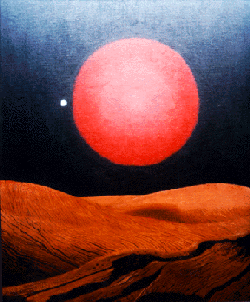Zeta Aurigae

Zeta Aurigae as portrayed by the artist Chesley Bonestell. © Bonestell Space Art, used with permission.
Zeta Aurigae is a famous eclipsing binary in the constellation Auriga and one of the Kids (in Latin "Haedus"). It is also known as Haedus I and by an astonishing coincidence, its constellation mate, Epsilon Aurigae, which is the second Kid ("Haedus II"), is also a well-known (and even more remarkable) eclipsing binary.
Zeta consists an orange supergiant (spectral type K4) in orbit around a blue B star (type B5) with a period of 972.2 days (2.66 years). Because the orientation of the orbit lies within 3° of our line of sight, every 2.66 years the smaller B star hides completely behind the larger K star (which is about as wide as Venus's orbit), and the combined visual light drops by 0.15 magnitude (about 15%). Averaging 4.2 astronomical units (AU) apart, the two go around each other in an elliptical orbit that takes them from 5.9 AU to 2.5 AU apart.
| visual magnitude | 3.69 |
| absolute magnitude | -3.23 |
| spectral type | K4II |
| surface temperature | 3,950 K (K star), 15,300 K (B star) |
| luminosity | 4,800 Lsun (K star), 1,000 Lsun (B star) |
| radius | 148 Rsun (K star), 4.5 Rsun (B star) |
| mass | 5.8 Msun (K star), 4.8 Msun (B star) |
| distance | 790 ± 150 light-years (242 ± 47 pc) |
| position | RA 05h 02m 28.7s; Dec +41° 04' 33" |
| other designations | Haedi Haedus, Sadatoni, Saclateni, 8 Aurigae, HR 1612, HD 32068, BD+40°1142A, FK5 1137, HIP 23453, SAO 39966, GC 6137, CCDM 05025+4105 |


